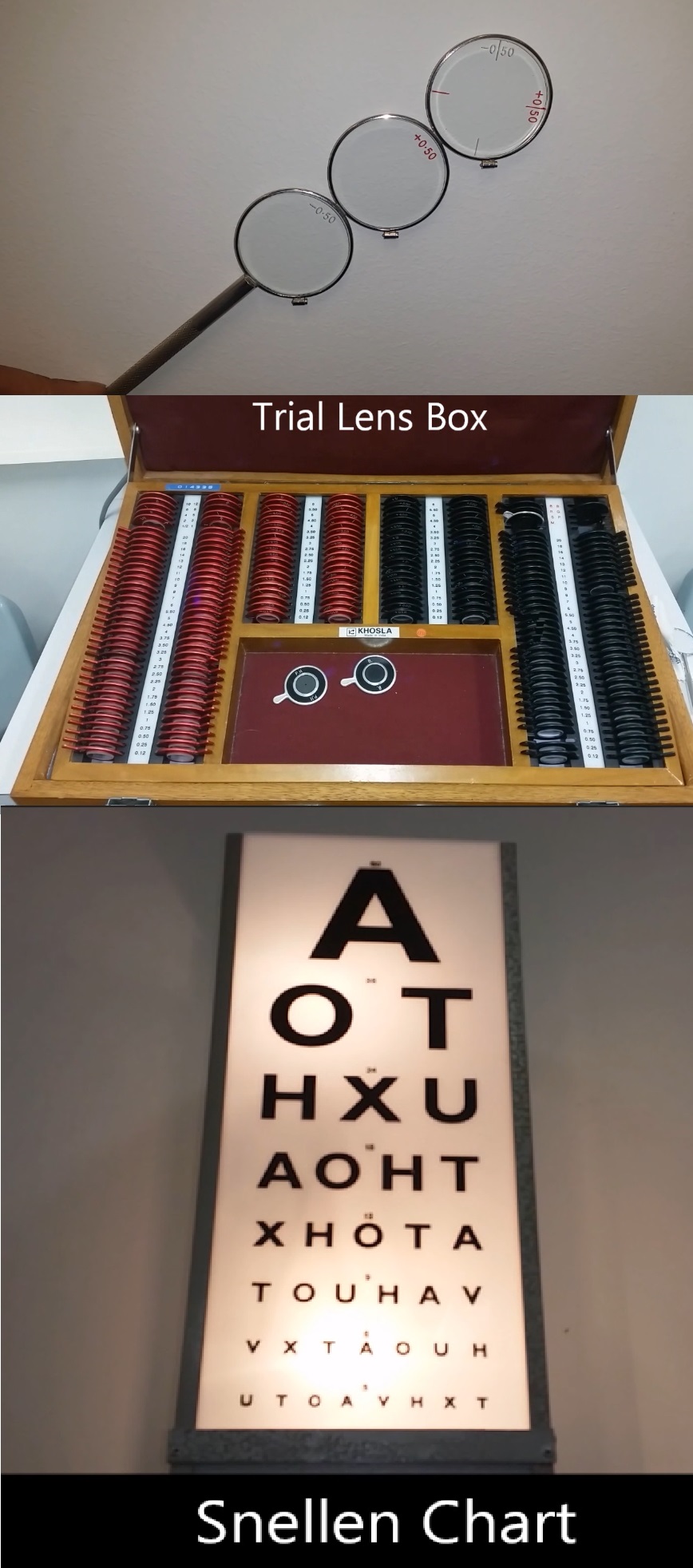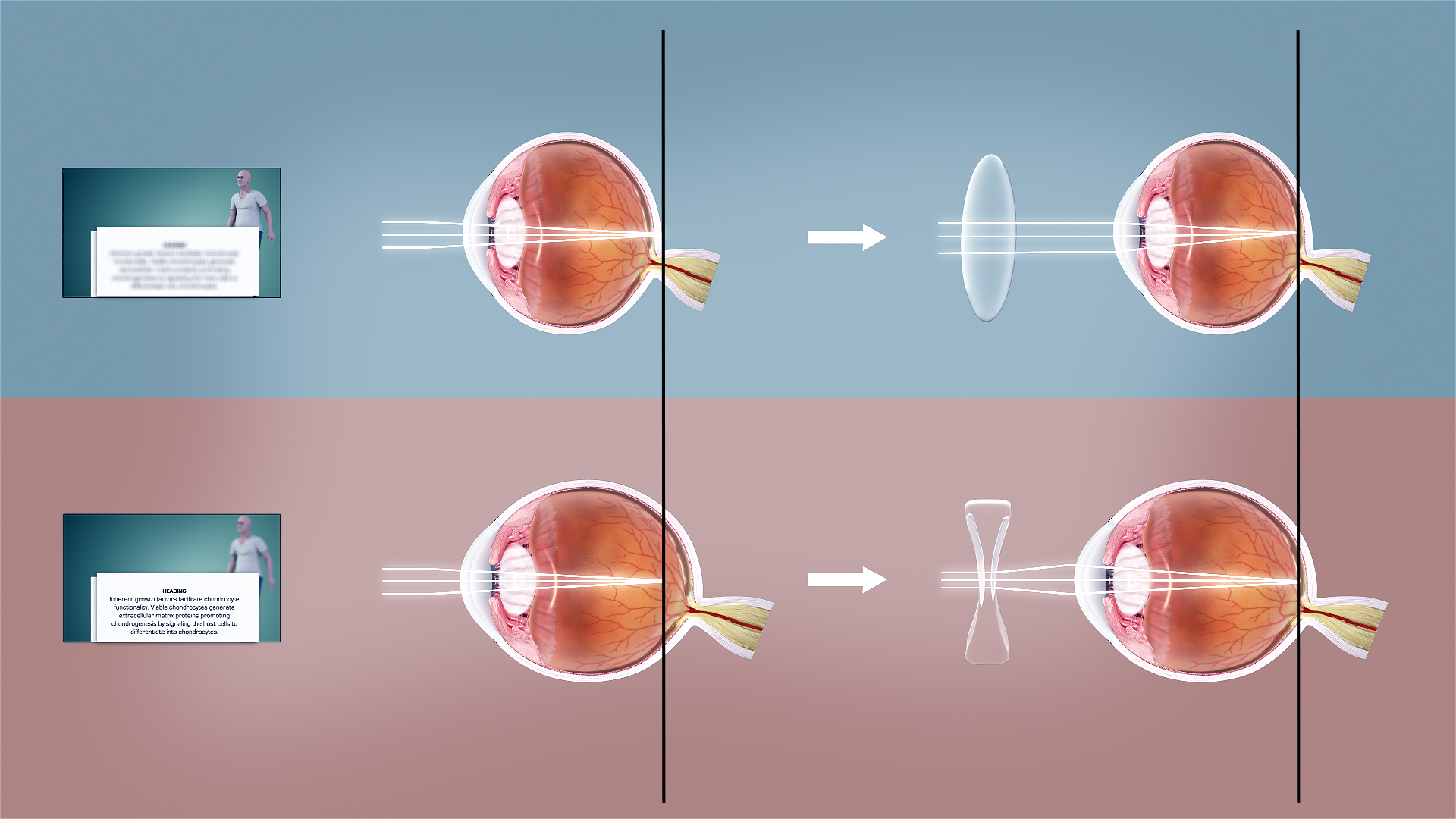|
Eye Examination
An eye examination is a series of tests performed to assess vision and ability to focus on and discern objects. It also includes other tests and examinations pertaining to the eyes. Eye examinations are primarily performed by an optometrist, ophthalmologist, or an orthoptist. Health care professionals often recommend that all people should have periodic and thorough eye examinations as part of routine primary care, especially since many eye diseases are asymptomatic. Eye examinations may detect potentially treatable blinding eye diseases, ocular manifestations of systemic disease, or signs of tumours or other anomalies of the brain. A full eye examination consists of an external examination, followed by specific tests for visual acuity, pupil function, extraocular muscle motility, visual fields, intraocular pressure and ophthalmoscopy through a dilated pupil. A minimal eye examination consists of tests for visual acuity, pupil function, and extraocular muscle motilit ... [...More Info...] [...Related Items...] OR: [Wikipedia] [Google] [Baidu] |
Snellen Chart
A Snellen chart is an eye chart that can be used to measure visual acuity. Snellen charts are named after the Dutch ophthalmologist Herman Snellen, who developed the chart in 1862. Many ophthalmologists and vision scientists now use an improved chart known as the LogMAR chart. History Snellen developed charts using symbols based in a 5×5 unit grid. The experimental charts developed in 1861 used abstract symbols. Snellen's charts published in 1862 used alphanumeric capitals in the 5×5 grid. The original chart shows A, C, E, G, L, N, P, R, T, 5, V, Z, B, D, 4, F, H, K, O, S, 3, U, Y, A, C, E, G, L, 2. Description The normal Snellen chart is printed with eleven lines of block letters. The first line consists of one very large letter, which may be one of several letters, for example E, H, or N. Subsequent rows have increasing numbers of letters that decrease in size. A person taking the test covers one eye from 6 metres or 20 feet away, and reads aloud the letters of each row, ... [...More Info...] [...Related Items...] OR: [Wikipedia] [Google] [Baidu] |
Intraocular Pressure
Intraocular pressure (IOP) is the fluid pressure inside the eye. Tonometry is the method eye care professionals use to determine this. IOP is an important aspect in the evaluation of patients at risk of glaucoma. Most tonometers are calibrated to measure pressure in millimeters of mercury (mmHg). Physiology Intraocular pressure is determined by the production and drainage of aqueous humour by the ciliary body and its drainage via the trabecular meshwork and uveoscleral outflow. The reason for this is because the vitreous humour in the posterior segment has a relatively fixed volume and thus does not affect intraocular pressure regulation. An important quantitative relationship (Goldmann's equation) is as follows: :P_o = \frac + P_v Where: * P_o is the IOP in millimeters of mercury (mmHg) * F the rate of aqueous humour formation in microliters per minute (μL/min) * U the resorption of aqueous humour through the uveoscleral route (μL/min) * C is the facility of outflow in m ... [...More Info...] [...Related Items...] OR: [Wikipedia] [Google] [Baidu] |
Subjective Refraction
Subjective Refraction is a technique to determine the combination of lenses that will provide the best corrected visual acuity (BCVA). It is a clinical examination used by orthoptists, optometrists and ophthalmologists to determine a patient's need for refractive correction, in the form of glasses or contact lenses. The aim is to improve current unaided vision or vision with current glasses. Glasses must also be comfortable visually. The sharpest final refraction is not always the final script the patient wears comfortably. Equipment & Requirements The following equipment is used to complete a Subjective Refraction: * Trial frames * Trial lens box & confirmation set: Including the pinhole and occluder * Jackson Cross Cylinder: a combination of two cylinders whose powers are numerically equal and of opposite sign (+/-) and whose axis are perpendicular to one another. This is used to search for astigmatism. * Snellen chart * Duochrome test: used to check the spherical component ... [...More Info...] [...Related Items...] OR: [Wikipedia] [Google] [Baidu] |
Auto-refractor
An autorefractor or automated refractor is a computer-controlled machine used during an eye examination to provide an objective measurement of a person's Refraction error, refractive error and Eyeglass prescription, prescription for glasses or contact lenses. This is achieved by measuring how light is changed as it enters a person's eye. Technique The majority of autorefractors calculate the vision correction a patient needs (refraction) by using sensors that detect the reflections from a cone of infrared light. These reflections are used to determine the size and shape of a ring in the retina which is located in the posterior part of the eye. By measuring this zone, the autorefractor can determine when a patient's eye properly focuses an image. The instrument changes its magnification until the image comes into focus. The process is repeated in at least three meridians of the eye and the autorefractor calculates the refraction of the eye, sphere, cylinder and axis. Modern autorefr ... [...More Info...] [...Related Items...] OR: [Wikipedia] [Google] [Baidu] |
Retinoscope
Retinoscopy (Ret) is a technique to obtain an objective measurement of the refractive error of a patient's eyes. The examiner uses a retinoscope to shine light into the patient's eye and observes the reflection (reflex) off the patient's retina. While moving the streak or spot of light across the pupil the examiner observes the relative movement of the reflex or manually places lenses over the eye (using a trial frame and trial lenses) to "neutralize" the reflex. Static retinoscopy is a type of retinoscopy used in determining a patient's refractive error. It relies on Foucault knife-edge test, which states that the examiner should simulate optical infinity to obtain the correct refractive power. Hence, a power corresponding to the working distance is subtracted from the gross retinoscopy value to give the patient's refractive condition, the working distance lens being one which has a focal length of the examiner's distance from the patient (e.g. +1.50 dioptre lens for a 67 cm ... [...More Info...] [...Related Items...] OR: [Wikipedia] [Google] [Baidu] |
Eyeglass Prescription
An eyeglass prescription is an order written by an eyewear prescriber, such as an optometrist, that specifies the value of all parameters the prescriber has deemed necessary to construct and/or dispense corrective lenses appropriate for a patient. If an eye examination indicates that corrective lenses are appropriate, the prescriber generally provides the patient with an eyewear prescription at the conclusion of the exam. The parameters specified on spectacle prescriptions vary, but typically include the patient's name, power of the lenses, any prism to be included, the pupillary distance, expiration date, and the prescriber's signature. The prescription is typically determined during a refraction, using a phoropter and asking the patient which of two lenses is better, or by automated refractor, or through the technique of retinoscopy. A dispensing optician will take a prescription written by an optometrist and order and/or assemble the frames and lenses to then be dispensed ... [...More Info...] [...Related Items...] OR: [Wikipedia] [Google] [Baidu] |
Astigmatism
Astigmatism is a type of refractive error due to rotational asymmetry in the eye's refractive power. This results in distorted or blurred vision at any distance. Other symptoms can include eyestrain, headaches, and trouble driving at night. Astigmatism often occurs at birth and can change or develop later in life. If it occurs in early life and is left untreated, it may result in amblyopia. The cause of astigmatism is unclear; however, it is believed to be partly related to genetic factors. The underlying mechanism involves an irregular curvature of the cornea and protective reaction changes in the lens of the eye, called lens astigmatism, that has the same mechanism as spasm of accomodation. Diagnosis is by an eye examination called autorefractor keratometry (objective, allows to see lens and cornea components of astigmatism) and subjective refraction, but subjective methods are almost always inaccurate, if lens astigmatism is not fully removed first with a week of ... [...More Info...] [...Related Items...] OR: [Wikipedia] [Google] [Baidu] |
Presbyopia
Presbyopia is physiological insufficiency of accommodation associated with the aging of the eye that results in progressively worsening ability to focus clearly on close objects. Also known as age-related farsightedness (or age-related long sight in the UK), it affects many adults over the age of 40. A common sign of presbyopia is difficulty reading small print which results in having to hold reading material farther away. Other symptoms associated can be headaches and eyestrain. Different people will have different degrees of problems. Other types of refractive errors may exist at the same time as presbyopia. This condition is similar to hypermetropia or far-sightedness which starts in childhood and exhibits similar symptoms of blur in the vision for close objects. Presbyopia is a typical part of the aging process. It occurs due to age related changes in the lens (decreased elasticity and increased hardness) and ciliary muscle (decreased strength and ability to move the l ... [...More Info...] [...Related Items...] OR: [Wikipedia] [Google] [Baidu] |
Hyperopia
Far-sightedness, also known as long-sightedness, hypermetropia, or hyperopia, is a condition of the eye where distant objects are seen clearly but near objects appear blurred. This blurred effect is due to incoming light being focused behind, instead of on, the retina wall due to insufficient accommodation by the lens. Minor hypermetropia in young patients is usually corrected by their accommodation, without any defects in vision. But, due to this accommodative effort for distant vision, people may complain of eye strain during prolonged reading. Some hypermetropes can see clear at distance, but near vision may be blurred due to insufficient accommodation. For this reason, this defect is referred as far-sightedness. If the hypermetropia is high, there will be defective vision for both distance and near. People may also experience accommodative dysfunction, binocular dysfunction, amblyopia, and strabismus. Newborns are almost invariably hypermetropic, but it gradually decreas ... [...More Info...] [...Related Items...] OR: [Wikipedia] [Google] [Baidu] |
Myopia
Near-sightedness, also known as myopia and short-sightedness, is an eye disease where light focuses in front of, instead of on, the retina. As a result, distant objects appear blurry while close objects appear normal. Other symptoms may include headaches and eye strain. Severe near-sightedness is associated with an increased risk of retinal detachment, cataracts, and glaucoma. The underlying mechanism involves the length of the eyeball growing too long or less commonly the lens being too strong. It is a type of refractive error. Diagnosis is by eye examination. Tentative evidence indicates that the risk of near-sightedness can be decreased by having young children spend more time outside. This decrease in risk may be related to natural light exposure. Near-sightedness can be corrected with eyeglasses, contact lenses, or a refractive surgery. Eyeglasses are the easiest and safest method of correction. Contact lenses can provide a wider field of vision, but are associat ... [...More Info...] [...Related Items...] OR: [Wikipedia] [Google] [Baidu] |
Refractive Error
Refractive error, also known as refraction error, is a problem with focusing light accurately on the retina due to the shape of the eye and or cornea. The most common types of refractive error are near-sightedness, far-sightedness, astigmatism, and presbyopia. Near-sightedness results in far away objects being blurry, far-sightedness and presbyopia result in close objects being blurry, and astigmatism causes objects to appear stretched out or blurry. Other symptoms may include double vision, headaches, and eye strain. Near-sightedness is due to the length of the eyeball being too long, far-sightedness the eyeball too short, astigmatism the cornea being the wrong shape, and presbyopia aging of the lens of the eye such that it cannot change shape sufficiently. Some refractive errors occur more often among those whose parents are affected. Diagnosis is by eye examination. Refractive errors are corrected with eyeglasses, contact lenses, or surgery. Eyeglasses are the easie ... [...More Info...] [...Related Items...] OR: [Wikipedia] [Google] [Baidu] |
Refraction
In physics, refraction is the redirection of a wave as it passes from one medium to another. The redirection can be caused by the wave's change in speed or by a change in the medium. Refraction of light is the most commonly observed phenomenon, but other waves such as sound waves and water waves also experience refraction. How much a wave is refracted is determined by the change in wave speed and the initial direction of wave propagation relative to the direction of change in speed. For light, refraction follows Snell's law, which states that, for a given pair of media, the ratio of the sines of the angle of incidence ''θ1'' and angle of refraction ''θ2'' is equal to the ratio of phase velocities (''v''1 / ''v''2) in the two media, or equivalently, to the refractive indices (''n''2 / ''n''1) of the two media. :\frac =\frac=\frac Optical prisms and lenses use refraction to redirect light, as does the human eye. The refractive index of materials varies with the wa ... [...More Info...] [...Related Items...] OR: [Wikipedia] [Google] [Baidu] |



.png)



